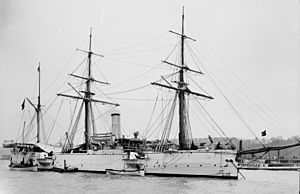Spanish cruiser Gravina facts for kids
Gravina was a type of ship called an unprotected cruiser in the Spanish Navy. It was part of the Velasco-class class. This ship was named after Federico Carlos Gravina y Nápoli, a famous Spanish admiral.

An unidentified Velasco-class (here called "Infanta Isabel-class") cruiser in U.S. waters during the 1880s or 1890s, showing the appearance of Gravina
|
|
Quick facts for kids History |
|
|---|---|
| Name | Gravina |
| Namesake | Federico Carlos Gravina y Nápoli |
| Builder | Thames Ironworks & Shipbuilding & Engineering Co. Ltd. |
| Launched | 1881 |
| Fate | Foundered 10 July 1884 |
| General characteristics | |
| Class and type | Velasco-class unprotected cruiser |
| Displacement | 1,152 tons |
| Length | 210 ft 0 in (64.01 m) |
| Beam | 32 ft 0 in (9.75 m) |
| Draft | 13 ft 8 in (4.17 m) maximum |
| Installed power | 1,500 ihp (1,100 kW) |
| Propulsion | 1-shaft, horizontal compound, 4-cylinder boilers |
| Sail plan | barque-rigged |
| Speed | 13 knots (24 km/h; 15 mph) |
| Complement | 173 officers and enlisted |
| Armament |
|
| Notes | 200 to 220 tons of coal (normal) |
Contents
About the Gravina Ship
The Gravina was a special kind of warship called an unprotected cruiser. This means it didn't have thick armor plates like some bigger warships, but it was still fast and carried powerful guns. It was built for the Spanish Navy to help protect Spain's interests around the world.
Building the Ship
Where Gravina Was Built
The Gravina was built in the United Kingdom by a company called Thames Ironworks & Shipbuilding & Engineering Co. Ltd.. This shipyard was located in Leamouth, a part of London. The building of the ship started in 1881.
How it Was Designed
The Gravina had a body made of iron. It also had a tall chimney, called a funnel, for its engines. Even though it was a modern ship with engines, it also had sails. It was rigged like a barque, which means it had a specific arrangement of masts and sails to help it move using wind power.
The Gravina and another ship, the Velasco, were built in the United Kingdom. They were a bit different from the other six ships of their class, which were built in Spain. The Gravina and Velasco had different weapons and could travel a little faster.
Ship's Life and Fate
After it was finished, the Gravina was sent to the Philippines. At that time, the Philippines was a territory of Spain. The ship's life was quite short. On July 10, 1884, the Gravina was caught in a very strong storm called a typhoon. Sadly, the ship sank during this storm. Two officers and seven crew members lost their lives in the incident.

